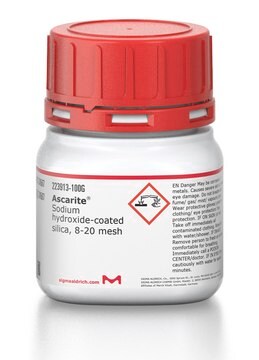367176
Hydroxyde de sodium
beads, 16-60 mesh, reagent grade, 97%
Synonyme(s) :
"Soude caustique"
About This Item
Produits recommandés
Qualité
reagent grade
Niveau de qualité
Densité de vapeur
>1 (vs air)
Pression de vapeur
<18 mmHg ( 20 °C)
3 mmHg ( 37 °C)
Essai
97%
Forme
beads
Technique(s)
titration: suitable
Taille des particules
16-60 mesh
Pf
318 °C (lit.)
Solubilité
water: soluble 1260 g/L at 20 °C
Densité
2.13 g/cm3
Chaîne SMILES
[OH-].[Na+]
InChI
1S/Na.H2O/h;1H2/q+1;/p-1
Clé InChI
HEMHJVSKTPXQMS-UHFFFAOYSA-M
Vous recherchez des produits similaires ? Visite Guide de comparaison des produits
Description générale
Application
- Titration methods.
- Dissolution testing.
- As a base for adjusting pH.
- As a reducing agent to initiate the synthesis of resin-supported silver nanoparticles.
- As an alternative to sodium hydride in the carbon-11 methylation reaction in the synthesis of [11C]diprenorphine.
- Preparation of bead cellulose loaded with iron oxyhydroxide (BCF).
- Synthesis of polyethyleneimine-sodium xanthogenate (PEX).
- Pretreatment of thickened waste activated sludge during anaerobic digestion.
- Struvite precipitation recycling technology.
- Production of sewage-sludge-based activated carbons.
- Preparation of β-cyclodextrin (β-CD)/cellulose hydrogels.
- Prion inactivation during industrial decontamination procedure.
- Pretreatment of sugarcane bagasse for the sugar recovery.
- In the Impinger to remove acidic gases.
Mention d'avertissement
Danger
Mentions de danger
Classification des risques
Eye Dam. 1 - Met. Corr. 1 - Skin Corr. 1A
Code de la classe de stockage
8B - Non-combustible corrosive hazardous materials
Classe de danger pour l'eau (WGK)
WGK 1
Point d'éclair (°F)
Not applicable
Point d'éclair (°C)
Not applicable
Faites votre choix parmi les versions les plus récentes :
Déjà en possession de ce produit ?
Retrouvez la documentation relative aux produits que vous avez récemment achetés dans la Bibliothèque de documents.
Les clients ont également consulté
Notre équipe de scientifiques dispose d'une expérience dans tous les secteurs de la recherche, notamment en sciences de la vie, science des matériaux, synthèse chimique, chromatographie, analyse et dans de nombreux autres domaines..
Contacter notre Service technique



